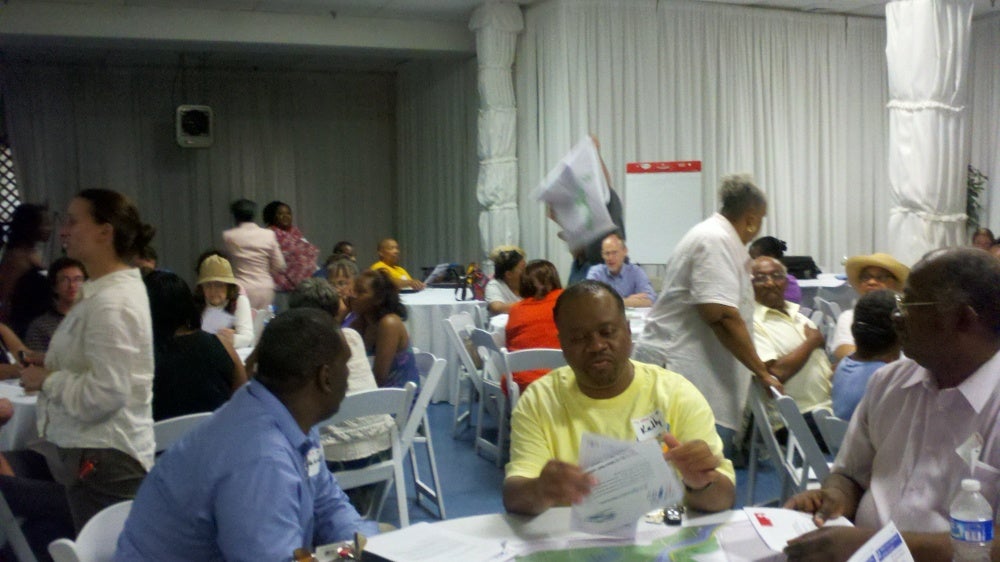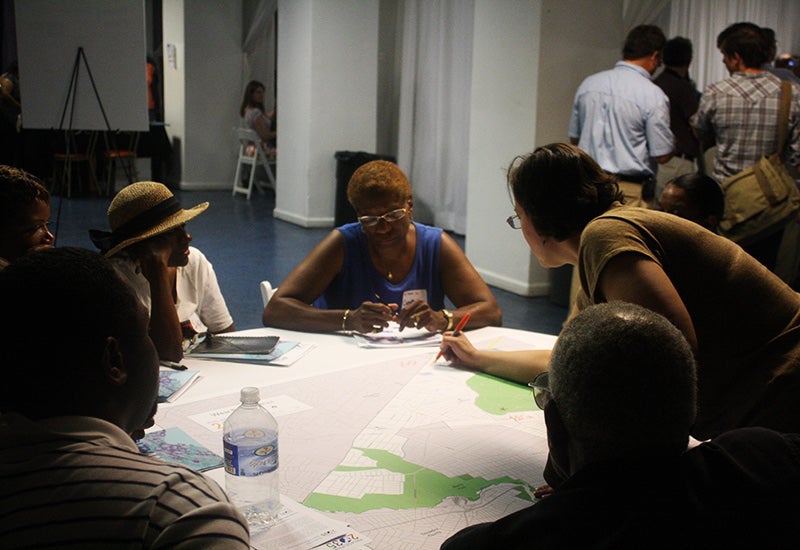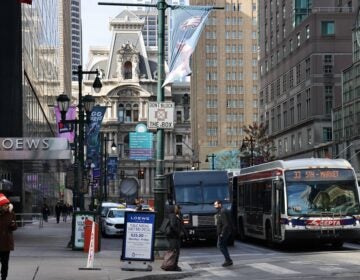Residents pack first input session for West Park portion of the city’s new comprehensive plan
Residents of Wynnefield, Parkside and other West Philadelphia neighborhoods that are clustered around Fairmount Park met last night to begin a six-month discussion with representatives of the Philadelphia City Planning Commission in order to lay out the future of their neighborhoods.
The meeting held at Park Avenue Banquet Hall on Parkside Avenue was the first public input session for the district-level portion of the city’s new comprehensive plan. The West Park district is one of 18 districts for which land use plans will be developed over the next 4 1/2 years. (Planners have also begun work on the Lower South district, which includes the port, Navy Yard, sports complexes and a handful of residential neighborhoods. The first public input session for that meeting is Tuesday night. See flyer here.)
More than 150 people packed the banquet hall – most, but not all, from the West Park district neighborhoods the city identified as East Parkside, West Parkside, Cathedral Park, Wynnefield, Wynnefield Heights, Overbrook, Overbrook Farms and Green Hill Farms.
They were divided into discussion groups of eight-to-10 people and asked by city planners stationed at each table to describe key destinations in the district and barriers to accessing those destinations. Participants identified parts of the community that feel stable and solid, and parts that they believe will change in the next ten years and how that change will occur.
Nearly 30 percent of the West Park district is comprised of Fairmount Park, and the men and women in the discussion group PlanPhilly sat in on see the park as an enormous asset and a key destination. But they said some of the attractions within the park – such as the Japanese Tea House – need to be better promoted and access by public transit should be improved.
Viola Street resident Mike Burch was so influenced by the time he spent in the park as a kid, with his friends and a telescope in the 1970s, that he became a scientist who is director of new programs at the Franklin Institute. Burch, who is also vice chair of the Viola Street Residents Association, said he sees lots of people from other parts of the city using the park for events like the recent triathlon, but there are no restaurants, cafes or other businesses in the area in which the visitors could spend time – and money – afterward. “There’s not even a place to get a cup of coffee,” he said.
Other group members similarly expressed a desire for stronger commercial corridors and more jobs.
Kelly Morris, a resident of nearby Mantua, said when he was growing up in the late 1960s and early ’70s, the area around Girard and 45th was “lit up like Las Vegas” at night. It was beautiful and safe, he said, and included a pharmacy with a lunch counter.
Morris said that when Jeff Brown moved a ShopRight into the relatively new plaza with the Lowe’s Home Improvement store, he created a destination. Morris said he was grateful to Brown for taking a chance on the neighborhood, but “I don’t think he has any regrets” because the store is busy night and day. Before it was built, several other participants agreed, there really was no place close by for grocery shopping.
Among other area destinations residents cited: St. Joe’s University, the Please Touch Museum, the School of the Future and a few other shopping centers.
Planning director Gary Jastrzab and community planner Andrew Meloney outline the evening’s process, and coming steps.
Participants said in some places in the area, walking anywhere is hampered by obstacles, such as railroad tracks that are hard to cross. They identified locations such as 52nd and Lancaster that are in need of left-turn signals, and said special events and busy zoo days sometimes clog up area streets. It was suggested that a SEPTA station at the zoo could do a lot to improve related traffic headaches.
Parts of Merion Avenue need to be cleaned of illegal dumping and prostitution, the group agreed, and some areas, such as between 40th and 42nd on Leidy Avenue, have a lot of vacant properties that would be improved with infill residential projects.
When director of community planning Richard Redding, the group’s facilitator, asked for areas that would remain the same over the next 10 years and those that would change, he received many more change responses.
The large institutions are some of the most stable components of the neighborhoods, but they will likely grow and change somewhat, participants said. Some said there was some town-and-gown tension with St. Joe’s because the university has bought up a lot of property.
While resident Cynthia Johnson, who has lived in Wynnefield for 32 years, offered several suggestions on how to improve things in the West Park neighborhoods – she noted the lack of public transportation in the park – she worries that improvements added to the abundant green space and Center City skyline views the area already boasts will yield to gentrification. That would mean that long-time residents will no longer be able to afford to stay in their neighborhood, she said. She’s seen it happen in other neighborhoods around Philadelphia. “You can’t stop it,” she said.
As each group provided feedback, planning commission staff members took notes and also made notations on a large map. The information will be compiled and a single map created. That composite map will soon be posted on the master plan’s website, www.phila2035.org. Also see that site for maps and other information about each district.
Monday night’s meeting was the first of three public input sessions that will be held on the West Park plan, said community planner Andrew Meloney. The next session, to be held sometime in September at a still-to-be-determined location, will focus on identifying several “opportunity areas” – locations that have potential for significant improvement. These areas will be fleshed out in the roughly 40 page district-level plan with renderings and other visuals as well as text, he said.
Planners will present their ideas for the areas that should be targeted, but will ask the community to either validate or dispute their choices, and perhaps suggest others. Some of the areas in the running include the Centennial District, the area around 52nd and Lancaster Avenue, and a portion of Parkside Avenue.
A report will be given on the results of the first two meetings at the third public input session, which will be held in November. More public comment will be taken, and a public hearing on a draft document will likely be held at the December planning commission meeting, Meloney said. The commission would then likely vote on the plan at its January meeting, he said.
That will not be the final step. The land use plan will inform zoning changes, and more public sessions will be held on those. Redding told his group that the idea is not to change zoning wholesale, but only in areas where the current zoning is outdated or otherwise not working.
Even that isn’t the end. So that the new comprehensive plan doesn’t get out of date, like the old one has, a cyclical review is built in. When the 18th plan is completed 4 1/2 years from now, planners will be looking at the West Park neighborhoods all over again.
Reach the reporter at kgates@planphilly.com.
WHYY is your source for fact-based, in-depth journalism and information. As a nonprofit organization, we rely on financial support from readers like you. Please give today.








